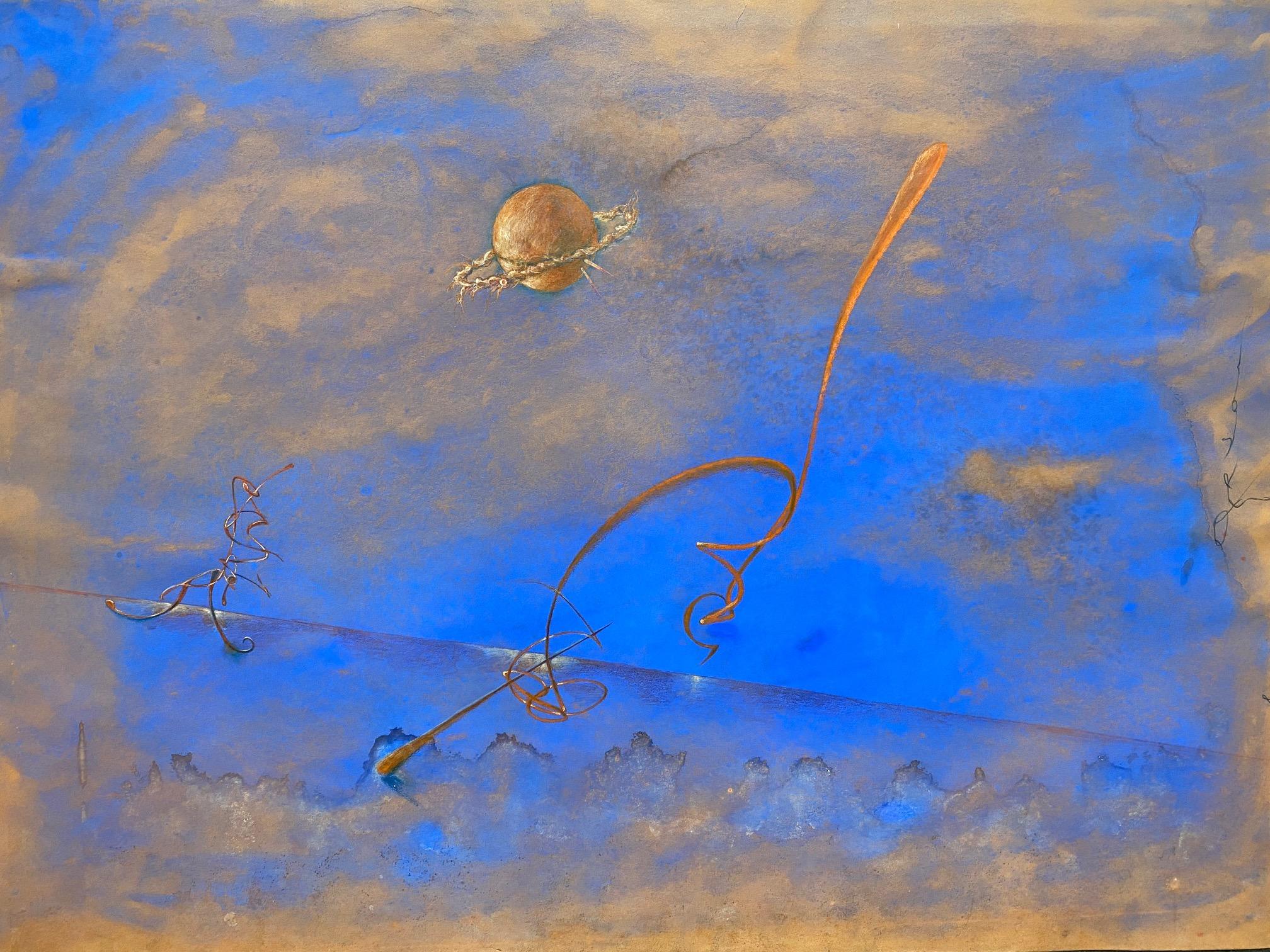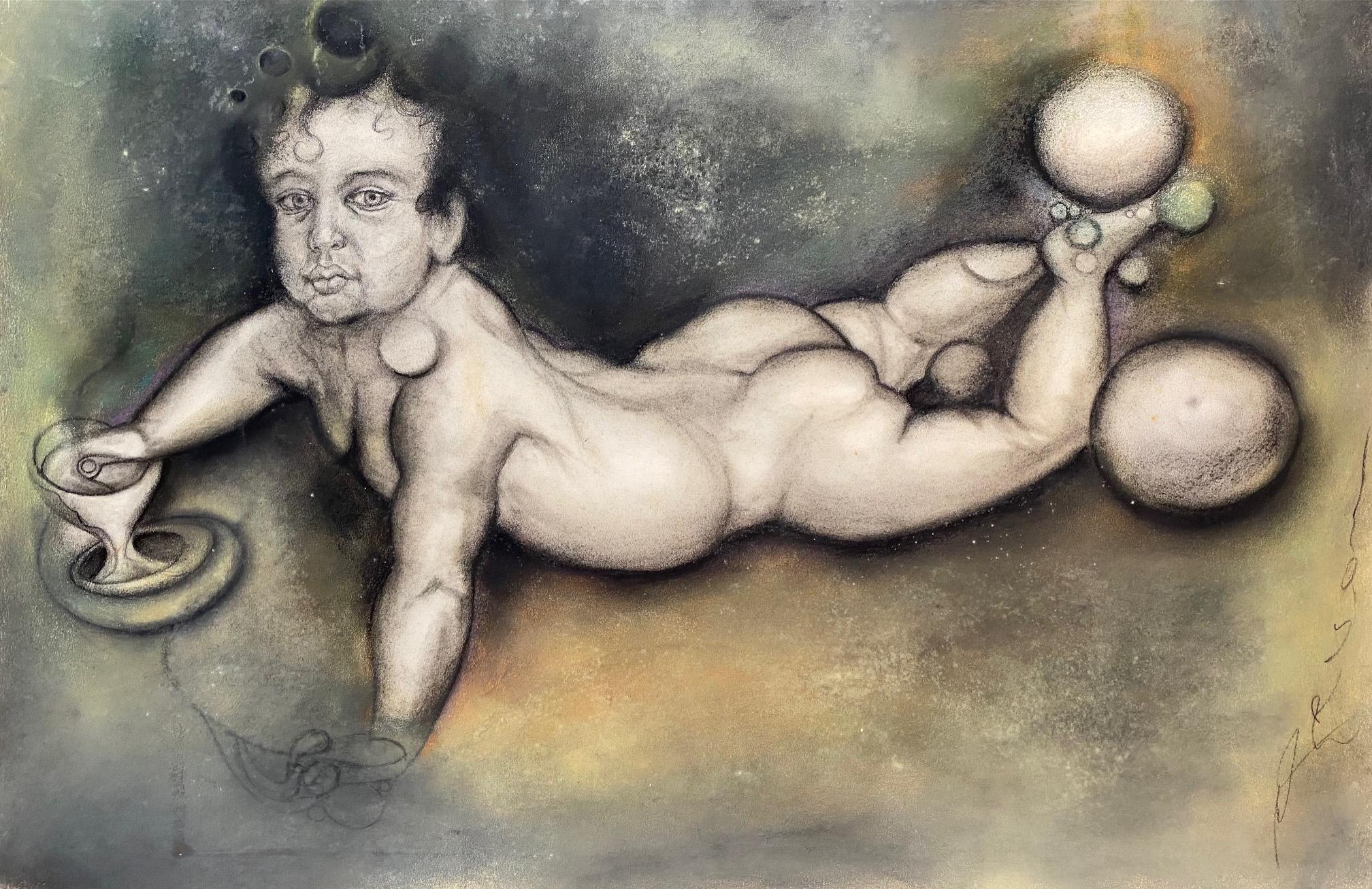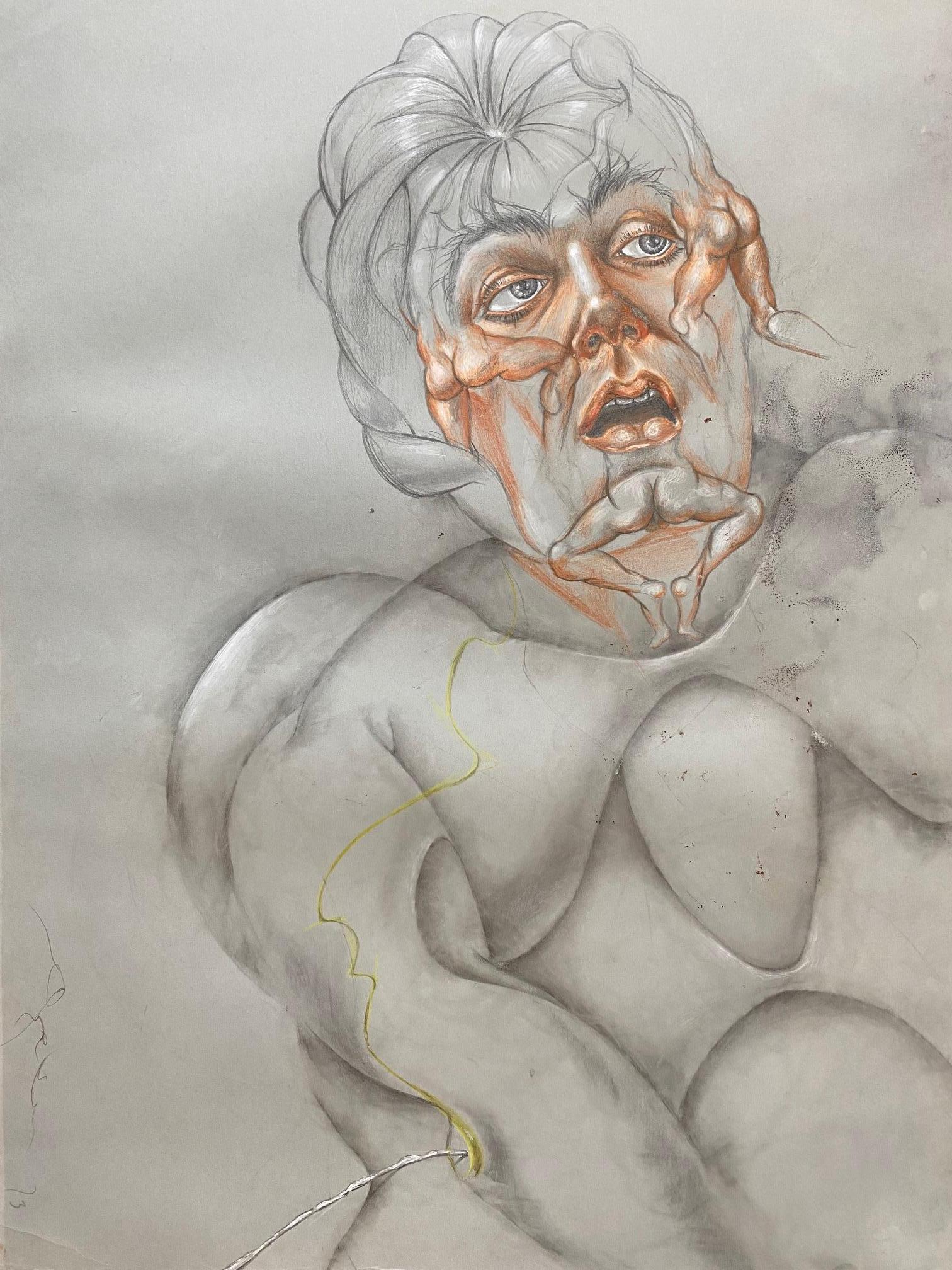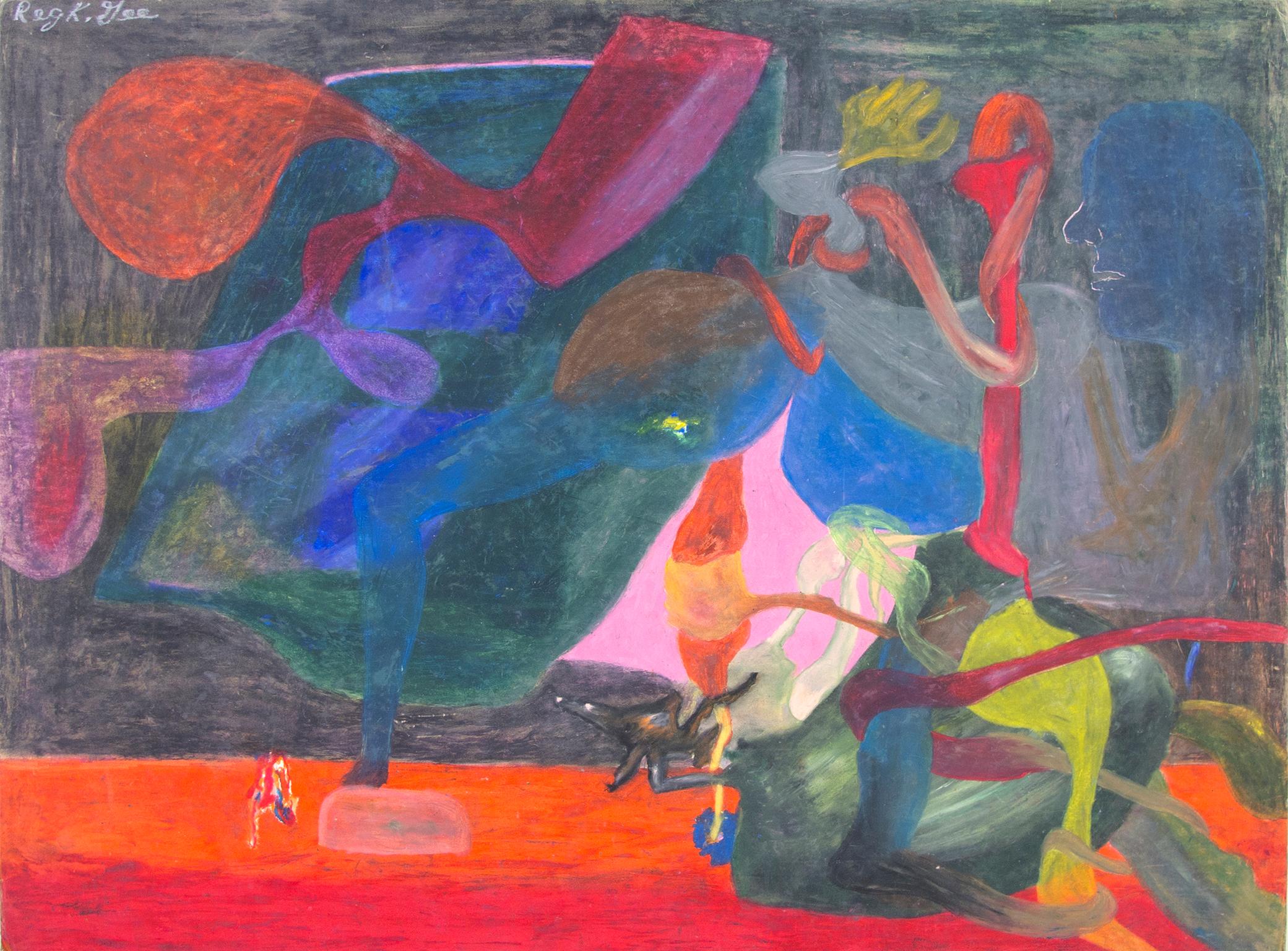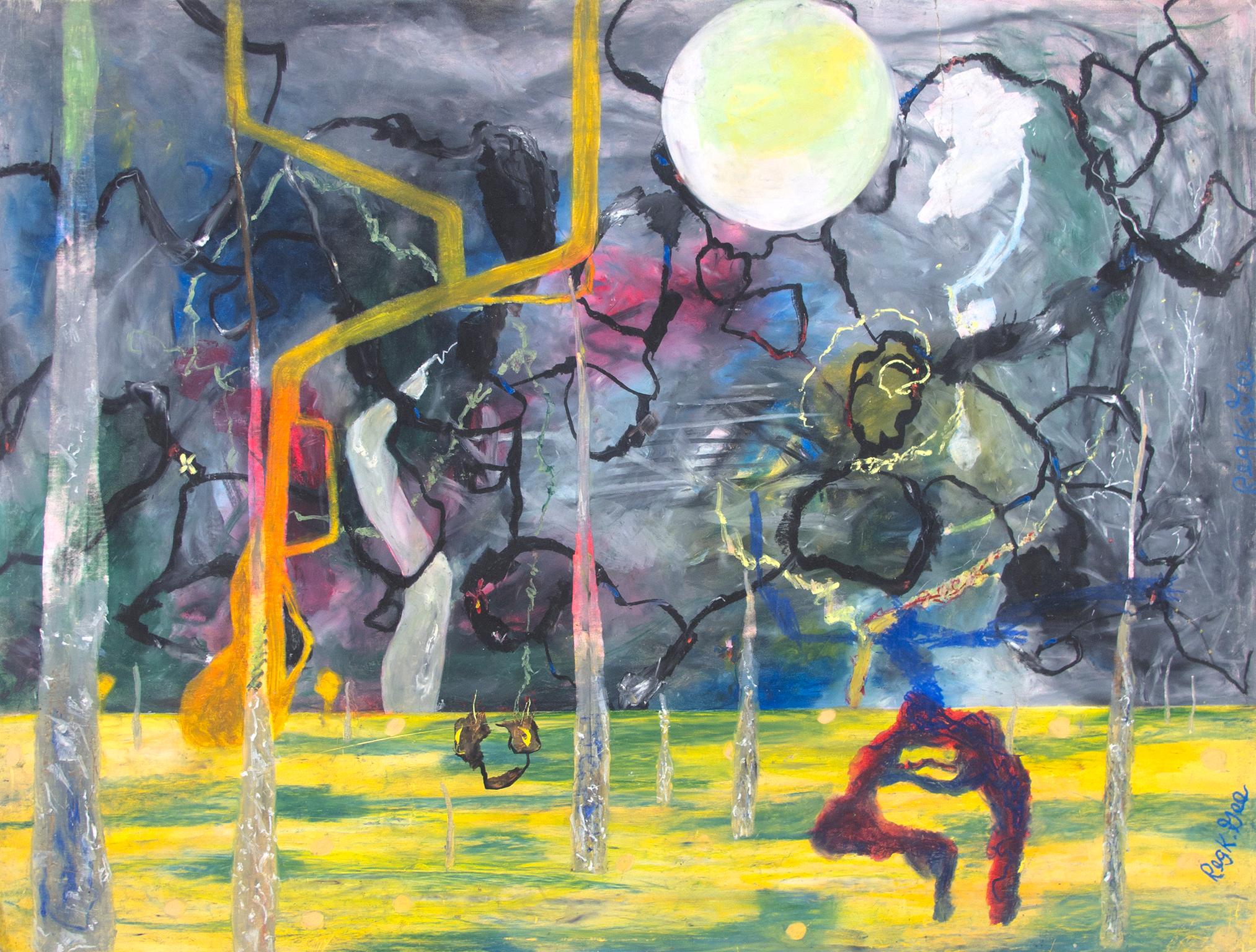Items Similar to Mouvement Spatiale, 1962 - crayon, 80x130 cm., framed.
Want more images or videos?
Request additional images or videos from the seller
1 of 6
Pierre DE MARIAMouvement Spatiale, 1962 - crayon, 80x130 cm., framed.1962
1962
About the Item
He was born in Paris, the son of a conversation though open-minded middle-class family. His father runs the family business of optical equipment but he's also a theatre lover, an author and a poet. He gives his son a strict education and the boy will feel closer to his mother. Pierre De Maria will become a honest, straightforward man, uncompromising to himself and the others. He is very particular about his appearance and, as a child of the "Belle époque" takes up to a kind of dandysm.
A cousin of his, Jacques Camoreyt (a pupil of Albert Maignan) teaches him how to master pictorial techniques along with the rather academic education in Arts he is going through. From 1907 to 1914 he is a student at the Lycée Condorcet, first graduates in science and languages, then at the Engineering College just before World War 1.
The sight of atrocities will leave a deep scar in his memory. He has a miraculous escape from the war and finds a job in the family firm. He soon realizes he hates everything related to engineering and decides to launch on into painting. He works as a scene painter with Ronsin and Laverdet workshop and on stage with "avant-garde" drama companies. In the same time, he shows his work at the "Salon d'Automne" in 1923 an gets a honour prize in the modern painting department.
In 1925 he takes up to boxing and creates some polychromatic facades with Djo Bourgeois, then gets into the Art Deco trend as an architect and a decorator.
Henri-Pierre Roché, a writer (Jules et Jim) a painter and an art collector close to the cubists has already discovered talents ( Brancusi, Wols…) and takes an in interest in Pierre De Maria.
Autoportrait
Environ 1960
In 1926 (the "Années Folles "in Paris) Pierre De Maria meets Marcel Duchamp, Brancusi and the surrealist gang he enjoys but never joins. « They were friends and I was curious but I never liked the hint of complaisance I saw in their work. »
He then starts some technical research an collages as shown in his first exhibition of "pasted gouaches" in Princess'Murat 's gallery in Paris. (« Fermé la nuit »)
« I never thought I'd make money with my paintings. I took to painting as I would have taken holy orders »
He works as a journalist for Marianne and Vu magazines (1932-1933) and writes a detailed report about the Maelström in Norway and the soviet Movies. He has the opportunity to meet Eisenstein and Poudovkine in Sovietic Russia and thinks of making a name for himself in the Movie industry.
In 1939 Pierre De Maria meets Germaine Pellegrino who becomes his wife a year later. They'll have two sons : Jacques born 1942 and François born 1943. The family settle in Geneva at the end of 1943.
During those years he writes an unpublished autobiographical novel («Tir à volonté») as well as a collection of thoughts about various topics such as war. He also writes poems and a play (as his father had done) «Cornelius'death», in a rather humorous manner. « He who conveys the opinion of fools makes certain to get the majority of votes ».
In 1944 he is back in Paris, leaving his wife. He'll settle in Nice in 1953 and starts there his mechanical period with the recurrent theme of machinery in his painting.
In 1958 he has his second exhibition in Paris (JC de Chaudun's gallery) and shows a series of lino-engravings done after some drawings of his: he then begins being acknowledged by his contemporaries, his fellow-painters and the Parisian artistic circle.
Jacques Prévert even dedicated him a poem. («Les Machinoutis») Henri Pierre Roché, Henri-Pieyre de Mandiargues, Yves Taillandier contribute to the catalogue, well received by the press.
In the meantime, he has his works exhibited at the Salon d'Automne, the Salon de Mai, and the Salon Comparaison.
In 1963, Flemish wood-engraver Frans Masereel, and Professor Gowa, the curator of the Offenbach Fine Arts, both introduce Pierre De Maria successfully in Germany, allowing him to become famous abroad. The Homo Atomicus Exhibition gathers 45 paintings, recounting the artist'progress over the past ten years. He's then nicknamed the «Atomic age Hyperonymus Bosch» !
In 1964, Greek gallery owner Iris Clert finds him out and helps him into a new career. He is then 68. Iris Clert, as a specialist in Contemporary Art has contributed to the coming out of the New Realism movement through her most spectacular and mediatical exhibitions. She takes a fancy to Pierre De Maria 's work : « The visit of his studio turned my love at first sight into a cutainty : he uses the technique from the Ancients to express Future. » Afterwards, both get into intense collaboration so that the painter is allowed to use the gallery owner's european and international net.
In 1966, his work's dedicated a research published in Connaissance des Arts Magazine n° 70 : » A foreground study of Pierre De Maria in this month issue ». Later an article in International Art.
In 1969 he turns 73 and he can see his first retrospective exhibition in Nice at the Ponchettes Gallery (about 60 paintings).
At 76, he meets artist Hélène Bottet, from then on allowing humour to take over violence in his art. Machines don't frighten him anymore, he's now able to mock them even through they remain at the core of his paintings, in spite of the mechanical Art of the Twenties having long ago been left behind by its creators.
In 1974, Jean Selz writes a chapter about « machines and sandhills » in his book Le dire et le faire.
That very year, he gets the President of the Republic Prize at the International Art Salon in Toulon for the « Burst Head » (La Tête éclatée).
In 1980, Jean Roger Soubiran has a new retrospective of his works organized in Marseilles Contemporary Art Centre. He gathers over a hundred paintings. It will be his last personal exhibition : he is 84.
He dies in 1984, an old, secret, bright and educated person. His life was a poetical adventure, successively an engineer, an architect, a reporter, a writer, a dandy, a Don Juan. Most of all he devoted himself to making his art the ideal of a life freed of any dogma.
He has left about 450 works. They can be seen at the New York NOMA (1968), at the Teheran Museum (1969), at the National contemporary Art foundation in Paris (1968), at the Cannes Museum (1982) and at the Quebec Museum.
- Creator:Pierre DE MARIA (1896 - 1984)
- Creation Year:1962
- Dimensions:Height: 31.5 in (80 cm)Width: 51.19 in (130 cm)
- Medium:
- Movement & Style:
- Period:
- Condition:
- Gallery Location:Nice, FR
- Reference Number:1stDibs: LU52833356133
About the Seller
4.8
Vetted Seller
These experienced sellers undergo a comprehensive evaluation by our team of in-house experts.
Established in 1998
1stDibs seller since 2016
78 sales on 1stDibs
Typical response time: Several days
- ShippingRetrieving quote...Ships From: Nice, France
- Return PolicyA return for this item may be initiated within 1 day of delivery.
More From This SellerView All
- Surrealist Composition, 1987 - gouache, 50x65 cm, framedBy Pierre de BerroetaLocated in Nice, FRGouache on paper, signed lower right (1914 – 2004) Né à Paris, Pierre DE BERROETA entre à l’Ecole Nationale Supérieure des Beaux-Arts de Paris en 1933. Ses œuvres s’inscrivent alors...Category
Late 20th Century Surrealist Abstract Drawings and Watercolors
MaterialsGouache
- lot of four surrealist inks - ink on paper, 10.5x30.5 cm., framedLocated in Nice, FRLot of four ink drawings by the german surrealist painter Sven Hauptmann. all signed. framedCategory
1970s Surrealist Abstract Drawings and Watercolors
MaterialsInk
- Abstract Composition HG , 1980 - pastel, 82x122 cm., framedBy Henri GoetzLocated in Nice, FRpastel on paper, signed lower right. Henri Bernard Goetz (September 29, 1909 – August 12, 1989) was a French American Surrealist painter and engraver. He is known for his artwork, a...Category
1970s Abstract Abstract Paintings
MaterialsPastel
- Abstract Composition EQ2, 1962 - crayon, 66x48 cm, framedBy Edmund QuincyLocated in Nice, FRFusain on paper, signed lower right.Category
1960s Abstract Abstract Drawings and Watercolors
MaterialsCrayon
- Abstract Composition EQ1, 1962 - crayon, 66x48 cm, framedBy Edmund QuincyLocated in Nice, FRFusain on paper, signed lower rightCategory
1960s Abstract Abstract Drawings and Watercolors
MaterialsCrayon
- Visage - gouache, 64x43 cm., encadréBy Albert ChubacLocated in Nice, FRGouache par Albert Chubac. Tampon de la vente de l'atelier Chubac. Encadré. Dimensions avec le cadre: 96 x76 cm. Last painter of the school of Nice. This is an important painter, the...Category
1960s Abstract Drawings and Watercolors
MaterialsGouache
You May Also Like
- The society gravitates to an uncertain core by José Gerson - Pastel 68x50 cmLocated in Geneva, CHWork on paper without frameCategory
1970s Surrealist Abstract Drawings and Watercolors
MaterialsPastel, Color Pencil
- Surrealist composition by José Gerson n°2 - Gouache on paper 42x62 cmLocated in Geneva, CHWork on paper without frameCategory
1970s Surrealist Abstract Drawings and Watercolors
MaterialsPastel, Gouache, Carbon Pencil
- Paysage linéaire by José Gerson - Gouache on paper 69x50 cmLocated in Geneva, CHWork on paper without frameCategory
1980s Surrealist Abstract Drawings and Watercolors
MaterialsPastel, Gouache, Carbon Pencil
- Surrealist composition by José Gerson n°3 - Pastel on paper 45x69 cmLocated in Geneva, CHWork on paper to frameCategory
1980s Surrealist Abstract Drawings and Watercolors
MaterialsPastel, Ink, Gouache
- "Therapeutic Horse Knowledge, " Oil Pastel on Board signed by Reginald K. GeeBy Reginald K. GeeLocated in Milwaukee, WI"Therapeutic Horse Knowledge" is an original oil pastel drawing on board by Reginald K. Gee. The artist signed the piece upper left. This piece features a surreal and abstract enviro...Category
1990s Surrealist Abstract Drawings and Watercolors
MaterialsOil Pastel, Board
- "Your New Home, " Abstract Surrealist Landscape Oil Pastel by Reginald K. GeeBy Reginald K. GeeLocated in Milwaukee, WI"Your New Home" is an original oil pastel drawing on illustration board by Reginald K. Gee. The artist signed the piece lower right. It features abstract, surreal, and biomorphic obj...Category
1990s Surrealist Abstract Drawings and Watercolors
MaterialsOil Pastel, Illustration Board
